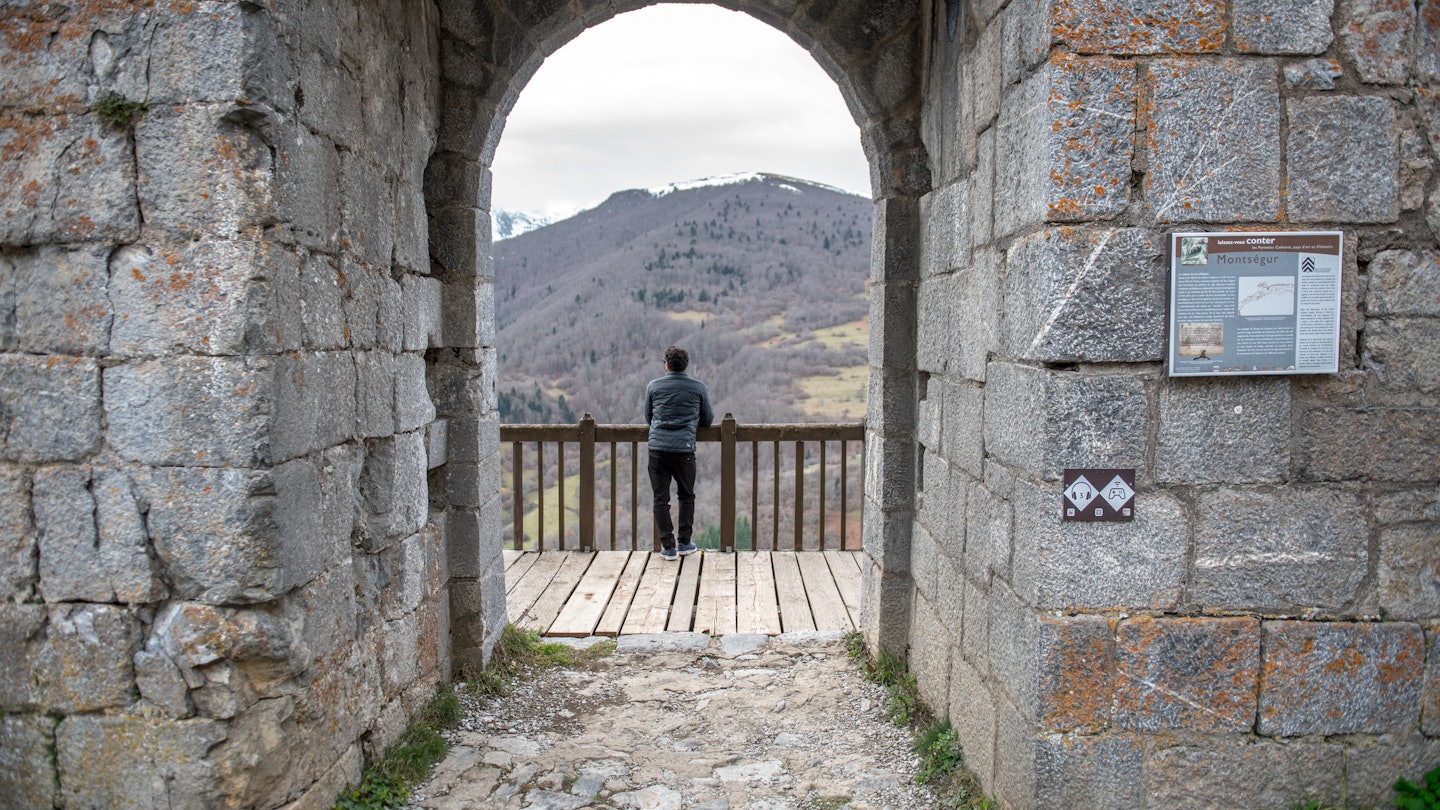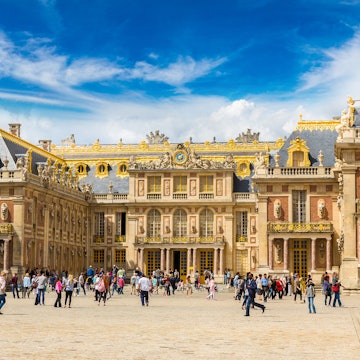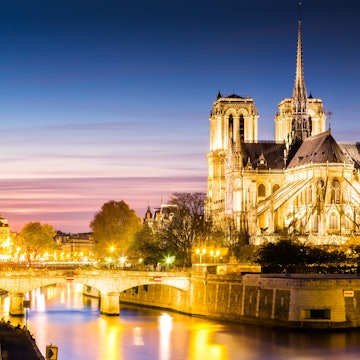
10 best castles in France: from formidable forts to lavish riverside châteaux

Dec 1, 2024 • 14 min read

It may involve a steep climb to reach it but the views from Château de Montségur are worth the effort © Martin Silva Cosentino / Getty Images
There was a time, hundreds of years ago, when the French royalty and nobility collected châteaux the way others collect stamps. Everyone wanted a piece of the palace pie, and as a result, France is sprinkled with some 40,000 châteaux, spanning epochs and flaunting their historic clout. This artistic sensibility and love of great, beautiful things that is so very French.
But not all châteaux are created equal: from elegant manors to mighty crag-clutching forts in the Pyrenees, castles laid to romantic ruin to the exquisite necklace of turreted Renaissance palaces strung along the Loire Valley, you’ll find that some grip you with their looks and others with their backdrops and bloody history. These are the ten best castles in France to visit.
1. Climb to the formidable fort of Château de Montségur
Best for dramatic mountain views
You can almost hear the stampeding hooves, crusading battle cries and clank of armor as you peer up at the great fist of rock punching above the wooded valley with the ruined fortress clinging to its top. Set against the cinematic backdrop of the French Pyrenees, in sun-scorched southern France’s Vallée de l’Ariège, Château de Montségur is the westernmost of the string of Cathar castles reaching across into Languedoc.
A medieval religious sect, the Cathars were in many ways quite ahead of their time – they were strict vegans who wanted equality, rejected the Catholic doctrine as immoral and believed in reincarnation. One thing is for sure: they knew how to build a good castle, even though it was here that they suffered their heaviest defeat in 1242 when the castle fell after an intense nine-month siege. Local legend has it that the Holy Grail was smuggled out of the castle to safety just before the defeat.
Planning tip: It’s a stiff 20-minute climb up from the village of Montségur. Avoid the midday sun and bring plenty of water.
Not to miss: The small Musée de Montségur in the village’s center showcases archaeological finds from the eponymous mountain and highlights the castle’s history.

2. Unleash fairy-tale fantasies at Château de Chambord
Best for sheer grandeur
Even Walt Disney couldn’t have dreamt up a château more sensational than the UNESCO-listed Château de Chambord, deep in the central Loire Valley, an hour’s drive east of Tours. Imagine the most perfect French Renaissance palace built on the scale of the Taj Mahal. Of all the ludicrously romantic Renaissance chateaux in the drowsy, river-woven Loire, this one has the fairy-tale edge, with its harmonious symmetry, silver witch-hat turrets, cupolas and domes, immaculately landscaped formal gardens, and wooded park home to stags, mouflon and wild boar.
The showpiece of the Loire châteaux, the palace is incredibly grand, but no one ever lived in it. François I started it as a weekend hunting retreat in 1519 but plans mushroomed, and the palace quickly went off the charts in terms of budget and scale: 426 rooms, 282 fireplaces and 77 staircases. After three decades and immeasurable expense in the making, François deemed his new pad "too drafty" and stayed here for just 72 days during his 32-year reign.
Planning tip: Plan a full day here, as there is much to see, including 18th-century kitchens, lavish royal bedchambers and the extraordinary double-helix staircase – allegedly designed by Leonardo da Vinci to stop the king’s wife from running into his mistress. With an interactive guide, maps and a treasure hunt for kids, HistoPad is great for a digital romp around the castle.
Not to miss: As if the château’s proportions weren’t stately enough, come in the morning or late afternoon, and you’ll see it magnified due to its reflection in the still, mirror-like waters of the Cosson Canal.
3. Marvel at the Pyrenees from Château de Foix
Best for medieval history fans
Mountains rise sheer and rugged like natural ramparts above this knockout of a triple-towered castle in Ariège in the eastern French Pyrenees, midway between Toulouse and the Spanish border. You’ll pinch yourself when you clap your eyes on this fantasy fortress, perched eyrie-like atop a crag. With its riot of turrets, towers and crenellations, this medieval beauty of a Cathar castle was the final stronghold of the powerful ruling Comtes de Foix. From the 16th century onwards, its fate took a darker turn as it was used as a jail.
The real magic comes as you approach on the cobbled track from the old town. While the castle’s bare interior may be anticlimactic, the battlements command astonishing views of the Pyrenees and the lushly wooded peaks of the Vallée de l'Ariège. Linger in the valley to explore rivers, caverns and waterfall-splashed canyons.
Not to miss: Spend some time strolling the narrow streets of the Foix’s medieval Old Town, which is as pretty as Pyrenees towns get. For food, check out Noï, which puts a creative spin on traditional French dishes.

4. Rewind to medieval times at Alpine Château d’Annecy
Best for visiting in warmer months
Reclining on the northern shore of its glittering turquoise lake and peering dreamily up to the French Alps, Annecy has a chilled-out southern vibe you wouldn’t expect in an Haute-Savoie town just an hour’s over-the-mountain drive west of ski central Chamonix.
And, it has a rather fabulous château: a perfect chess-piece castle of ochre-stone towers and terracotta turrets that presides over the jumbled rooftops and web of emerald canals that form the Vieille Ville (Old Town). A fine example of a medieval castle, the château was the stomping ground of the counts of Geneva during the 13th and 14th centuries, a military barracks in the 1940s, and was classified as a historical monument in the 1950s.
The views stretch across Annecy and its lake to the peaks of the Parc Naturel Régional du Massif des Bauges.
Planning tip: A dual-entry ticket grants access to both the Château and the Palais de l'Isle, so make time to visit both.
Not to miss: Visit the château’s museum for a shot of culture in the form of regional art, medieval sculpture, Savoyard furniture, Alpine landscape painting and contemporary art.
5. Revel in Richard the Lionheart tales at Château Gaillard
Best castle to visit in Normandy
If you prefer mist-swirled forts to fancy palaces and brooding ruins to bombastic interiors, the cliff-hugging Château Gaillard in Normandy will have you in raptures. An hour south of Rouen, this heart-stopper of a romantic ruin towers above the quaint village of Les Andelys on a particularly scenic bend in the Seine River.
Created out of the rock, the castle looks like the mad genius of a bold and ambitious king. It was built by Richard the Lionheart in the 12th century to guard the Seine River approach to Normandy and secure the western border of English territory until Henry IV ordered its destruction in 1603 (it first fell in 1204). When it was completed, word has it the king declared it gaillard, which can be translated as "saucy," "strapping," or "defiant" (take your pick).
The magnificent bastion certainly impresses with its inner bailey, upper court and dungeons. But it's the views from the château grounds that stay with you, especially as sunset golds render the castle into silhouette and the Seine twists away into the watercolor distance.
Not to miss: With a terrace overlooking the St. Savior Church of Petit-Andely and the village’s main street, Le Café du Petit Andely is a go-to coffee-drinking spot at the footsteps of Château Gaillard.

6. Get lost in Loire romance at Château de Villandry
Best for beautifully landscaped gardens
Following the meandering Loire River west of Tours brings you to this resplendent Château de Villandry. You might do a double take when you see its stately but mismatched appearance – all harmonious Renaissance beauty but for the keep of the medieval feudal fortress that was otherwise razed to the ground in 1532. The donjon pays homage to the place where Henry II of England (Henry Plantagenet) admitted defeat to King Philip Augustus of France, signing the La Paix de Colombiers treaty two days before he died.
Unlike many, this palace wasn’t built for royalty but for Jean Le Breton, who served François I as finance minister and ambassador to Italy. You’ll see his passion for art and far-flung lands in the Oriental drawing room, with its gilded Moorish ceiling and gallery of Spanish and Flemish art.
Le Breton was fond of Italian Renaissance gardening, and it shows. The château’s landscaped gardens shine with fountains, cascading flowers and vines, impressive topiary and box hedges. Exploring, you’ll come across the Jardin d'Eau (Water Garden), the hornbeam Labyrinthe (Maze) and the 16th-century-style Jardin des Simples (Kitchen Garden), where cabbages, leeks and carrots are laid out to create nine geometrical, color-coordinated squares.
Planning tip: Come from April to October to see the beautiful gardens in full bud and bloom.
Not to miss: Don’t leave without getting a view of the Loire and Cher rivers from the top of the keep and three belvédères (hillside panoramic viewpoints).
7. Live the fantasy of the Sun King at Château de Versailles
Best for seeing an iconic European castle
If you were Louis XIV back in the 17th century, with all the riches you could desire and France’s future at your fingertips, what better way to exert your influence than by building Versailles, a palace to outpomp them all? It literally projected the might of the French monarchy. The palace was built on a scale that beggars belief – 700 rooms, 2153 windows, 67 staircases, paintings laid 11km/6.8 miles end to end and 5000 objets d’art.
Sparing no expense, the Roi Soleil (Sun King) enlisted the most ingenious artisans of the age: architect Louis Le Vau, painter and interior designer Charles Le Brun and landscape gardener André Le Nôtre for this task. Together with 30,000 workers, the artists managed to decorate every last inch of the palace with gold leaf, frescoes, marble, intricate wood carvings and scenes drawing richly on Greek and Roman mythology – swiftly and efficiently draining the country's coffers as they did so.
And my, my is the result magnificent. Not without reason do 10 million people flock from Paris and far beyond to the leafy, bourgeois suburb of Versailles to see the palace par excellence each year. Prepare to be blown away by the Grands Appartements du Roi et de la Reine (King’s and Queen’s State Apartments), with rooms devoted to Hercules, Venus, Diana, Mars and Mercury, and the staggeringly opulent Galerie des Glaces (Hall of Mirrors), a 75m-long (246ft) ballroom with 17 huge mirrors on one side and, on the other, an equal number of windows looking out over the gardens and the setting sun.
Planning tip: Book tickets online to skip the queue, consider opening times (it’s closed on Monday and at its busiest on Tuesday, Saturday and Sunday), arrive early morning and download the app for an audio guide and map of the estate. To see off-limits areas of the palace, pre-book a guided tour.
Not to miss: The formal gardens are as sublime as the palace itself, with their geometrically aligned terraces, dancing fountains, flower beds, mythological sculptures and Grand Canal, oriented to reflect the sun that Louis XIV worshipped so ardently.
8. Fall for the Renaissance charms of Château d’Azay-le-Rideau
Best for fairytale lovers
Swirling in Renaissance romance, 16th-century Château d’Azay-le-Rideau, a short hop south of Tours, is quite possibly the Loire Valley château of your wildest dreams – a graceful, perfectly proportioned vision of creamy stone, steep slate roofs and silver turrets, vainly admiring its reflection in the waters of its moat. On an island in the middle of the Indre River, it’s so lovely you half expect a Disney princess to come wafting out of the door any second.
Your spin of the château will undoubtedly take in the splendid Italian-style loggia staircase overlooking the central courtyard, embellished with salamanders and ermines – the emblems used by François I and Queen Claude. The largely 19th-century interiors were fashioned by Marquis Charles de Biencourt (who bought the château after the Revolution) and his heirs. The lovely English-style gardens were restored and partly replanted from 2015 to 2017; the Jardin des Secrets (April to September) features heritage vegetables and flowers.
Planning tip: Audioguides are available in five languages; one-hour guided tours in French are free. In the Pressoir (the outbuilding to the right as you exit the ticket-sales hall), there's a worthwhile exposition on construction methods and materials, decorative motifs and the restoration of antique furnishings; the videos of experts at work are fascinating.
Not to miss: Wander the English-style gardens and the Jardin des Secrets, planted with a fantasy of heritage flowers and vegetables. For scenic dining, head to L'Aigle d'Or, an excellent French restaurant in a restored 19th-century villa on the Azay-le-Rideau outskirts.
9. Get mesmerized by the enormous Palace of Fontainebleau
Best for a Paris day trip
The French palatial grandeur is on full display at the gargantuan Château de Fontainebleau. One of the closest grand palaces to Paris (only 55 kilometers from the capital’s heart), it’s a complex filled with so much architectural and natural beauty that you might feel delightfully overwhelmed when you arrive. Walking through its vast grounds and numerous halls is akin to reading a book on French history.
Founded in the 12th century as a modest hunting lodge, French sovereigns gradually transformed the Palace of Fontainebleau into an art-filled architectural masterpiece.
You’ll visit five courtyards, a kaleidoscope of seemingly never ending stucco-decorated halls, dazzling imperial rooms and even a full-fledged theater. And then there are sprawling gardens with ponds, hiking trails and canals reflecting centuries of French landscape design. No wonder Fontainebleau was Napoleon Bonaparte’s most beloved chateau.
Planning tip: Admission is free on the first Sunday of each month, except in July and August and during certain national events.
Not to miss: Empress Eugénie-founded Musée Chinois de l’Impératice Eugénie (or Chinese Museum of Empress Eugénie) is a quintessential attraction housing more than 800 art objects from the Far East.
10. Admire the cinematic looks of Château de Chenonceau
Best for art lovers
There’s hardly a more graceful château in France than Chenonceau. You can’t help but admire its fantasy setting right on the Cher River’s calm waters. Once an unassuming mill, the site was turned into an elegant Renaissance dwelling in the early 15th century by Thomas Bohier, a chamberlain to King Charles VIII of France.
The castle’s embellishment was primarily overseen by women in the following centuries, so it’s often nicknamed Le Château des Dames. Henry II’s mistress, Diane de Poitiers, commissioned the beautiful arched bridge from the keep to the river palace. After Henry II’s death, the castle was managed by his wife, Catherine de' Medici, who expanded the gardens. Then, in the 18th century, under the ownership of Louise Dupin, the palace became a meeting place for the Enlightenment’s elite, hosting the likes of Voltaire, Montesquieu and Rousseau.
Today, Château de Chenonceau is France's second most visited palace after Versailles. Its elegant looks are simply irresistible and aesthetically pleasing. The waterside setting makes the palace even more photogenic. Moreover, you’ve got all the cinematic palatial attributes, such as a maze, a rose garden and boat tours. The interior is decorated with rare furnishings and an art collection that includes works by Tintoretto, Correggio, Rubens, Murillo, Van Dyck and Ribera (look for an extraordinary portrait of Louis XIV).
Planning tip: Tickets can be bought online in advance or at the ticket office upon arrival. The audio guide is available in 16 languages. Plan on spending at least half a day here. Wheelchairs are available free of charge, and there's a ramp into the château and toilets. The shop and the gardens are fully accessible.
Not to miss: Take a 50-minute La Bélandre cruise along the Cher River for the most romantic Chenonceau experience.
General tips on visiting the castles in France
Many travelers will commence their French palace connaissance from Paris. The great news is that many spectacular castles can be easily reached from the capital on a day trip. Château de Fontainebleau and Versailles are the two closest palatial masterpieces to Paris. Both are well-served by SNCF trains, making it an easy half-day journey.
It’s the Loire Valley, though, where you find the biggest concentration of châteaux. Stretching from Orléans to Angers along the Loire River, it’s home to over 300 castles. To have the best visiting experience without rushing it, make a plan for the palaces you want to see and stick to it. This will also help you to choose the towns you’ll base yourself in.
Reaching Loire attractions from Paris is relatively easy using TGV trains to one of the area’s towns. Tours is located in the heart of the UNESCO-protected region, making it a popular base for exploration, though you will still need a rental car or ride share to reach many of the chateaux directly. Hiring a car is the best way to make the most of Loire road trips and travel between castles that are outside big towns. Public transport is a budget-friendly and valid option, too – just check schedules and routes beforehand.
Keep planning your trip to France
Find the best time to visit and the best places to go.
Discover tips for traveling to France and getting around.
Learn how to budget your trip.















